How volatile have Google rankings really been?
Rank volatility increased by 26% in 2024 – some industries saw even bigger spikes. Explore the data and insights.
Some things in life are constant – Google rankings aren’t one of them.
If you’ve been paying attention (or just reading this website), you’ve likely noticed that rankings are becoming increasingly unstable. Industry veterans, with years of context, may feel this shift the most.
That’s why I believe SEO is evolving into something new.
What that means – and whether the industry is adapting well – is a discussion for another time (TL;DR: we’re not doing great, but we’re not failing either. Change is hard).
One key driver of this shift is SERP instability.
What I’d like to do here is explore that notion and give some concrete facts.
The average level of volatility in 2024
Rank was 26% more volatile in 2024 than in 2023.
It’s not as simple as it sounds, which is why we’ll look at multiple metrics to create a data picture as best we can.
However, if you looked at how much rank volatility increased in 2024 and compared it to how much it either increased or decreased in 2023, the answer would be 26% – at least on desktop.
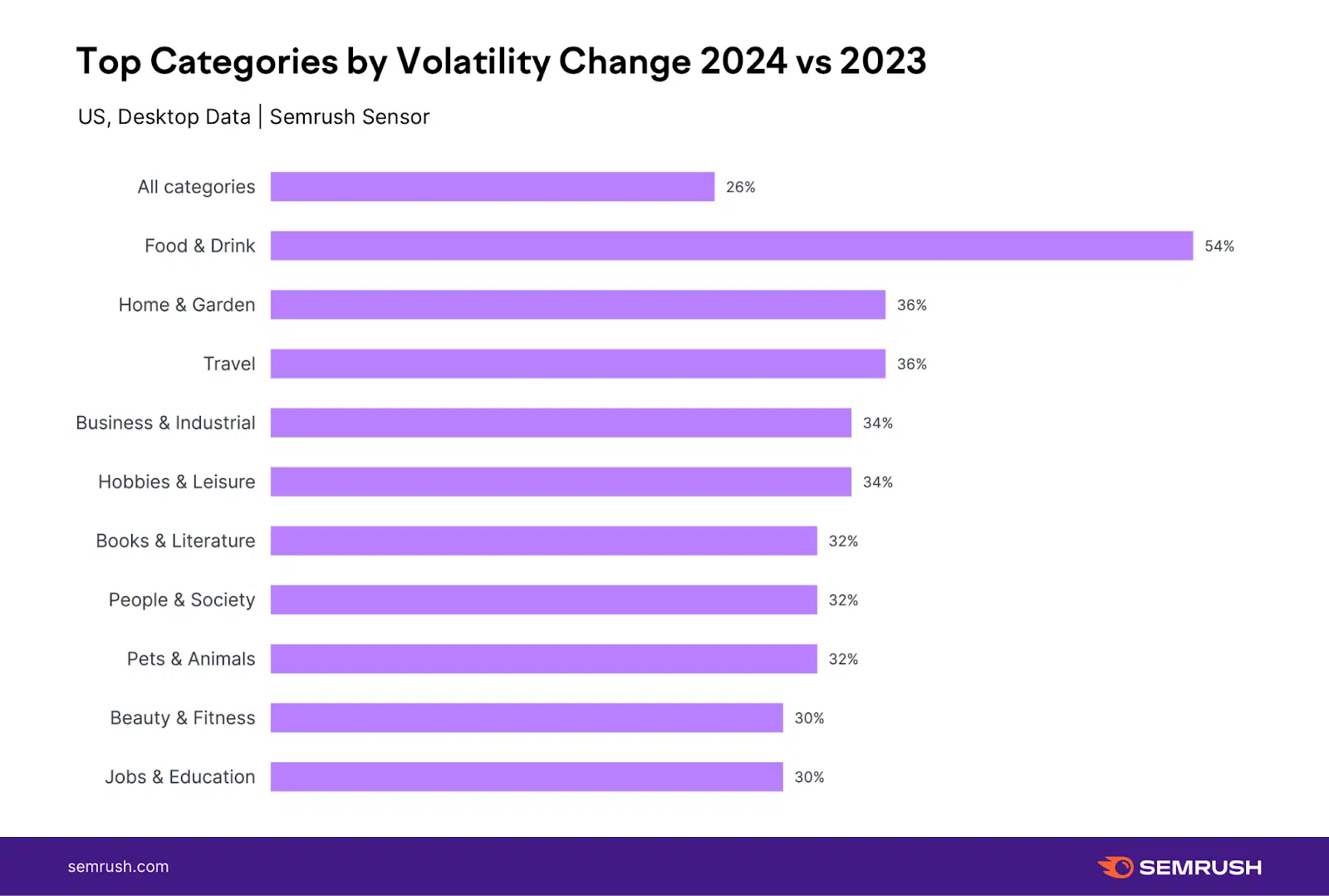
Now, that’s not universal across every sector of the web.
For example, as you can see above, certain niche industries saw far higher volatility increases in 2024 relative to 2023.
If your site helps folks relish information about their favorite snack, it might be over 50% more volatile (for the record, relish is no one’s favorite snack).
However, what was almost universal was that all but one of the vertical’s Semrush tracks saw an increase in rank volatility in 2024:
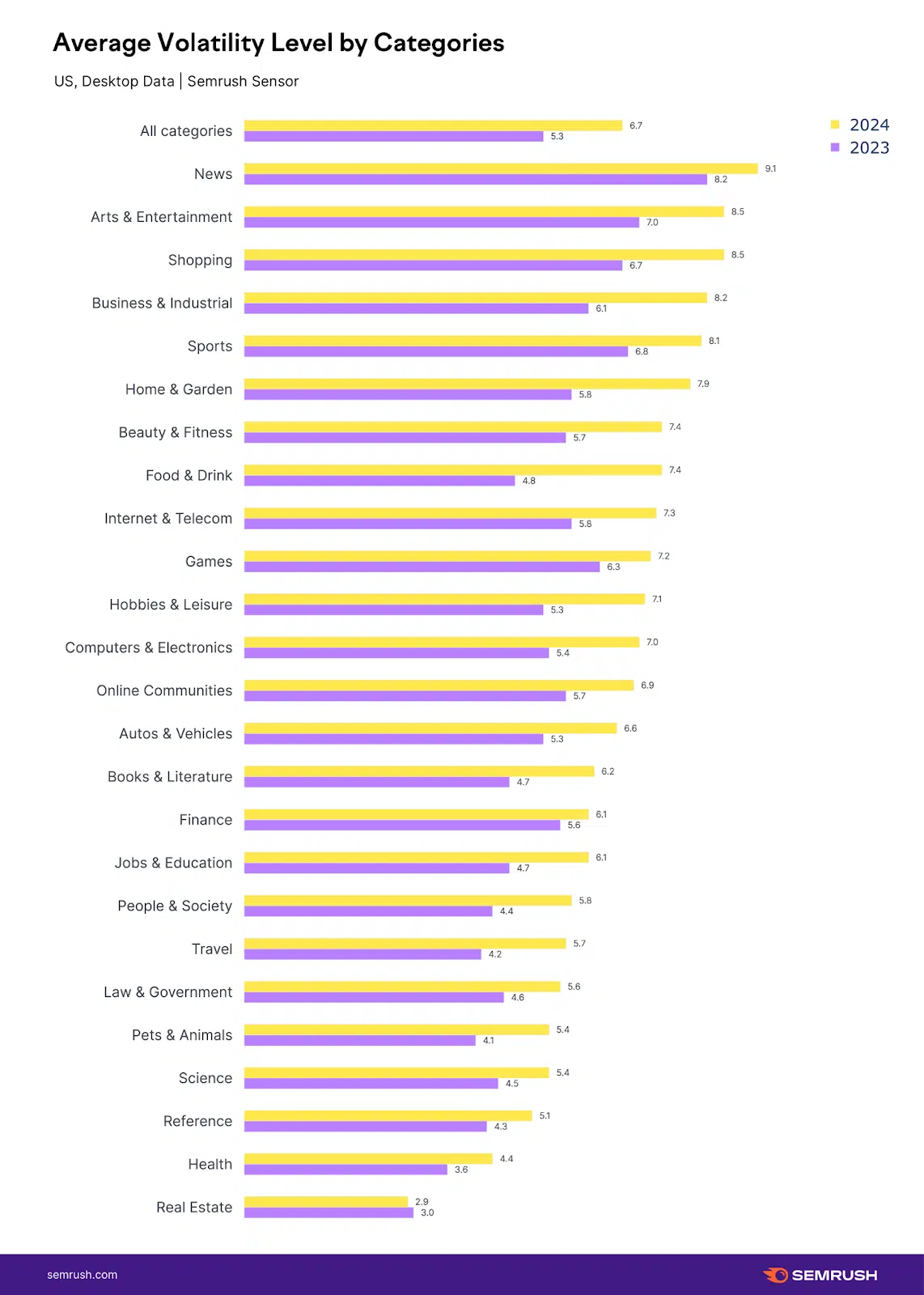
All but one vertical (Real Estate) saw what I would call a “noticeable” increase in rank volatility over the course of 2024 compared to 2023 (which itself was “noticeable”).
I want to highlight that the data shows average volatility – already high in 2023 and even higher in 2024 (except for Real Estate).
I don’t always report on desktop versus mobile when discussing Google algorithm updates.
In general, the numbers across devices are close enough that it doesn’t justify wasting your time.
In this case, the difference between devices was clear – a full 10 percentage points.
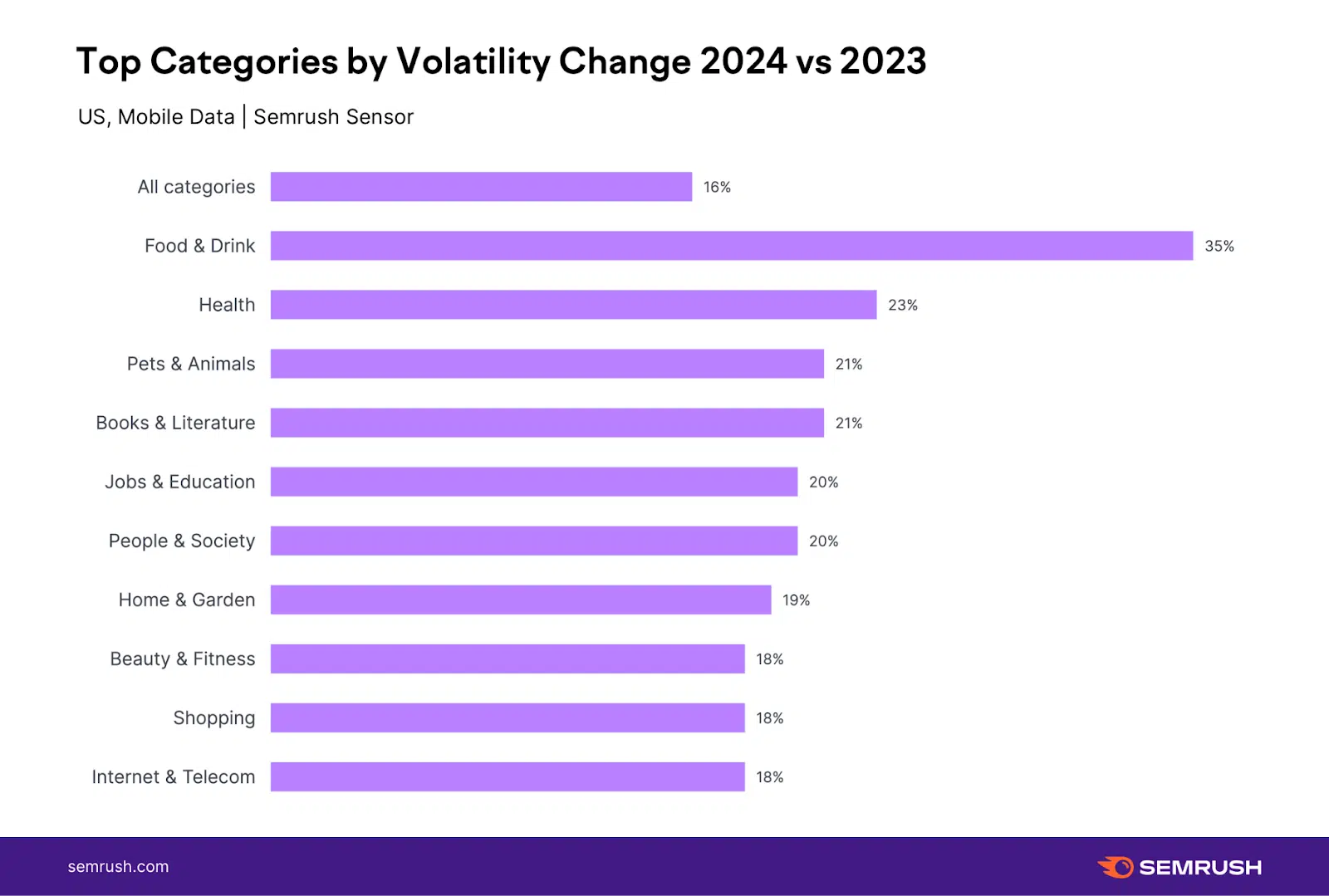
While the desktop SERP was 26% more volatile in 2024 than in 2023, the mobile SERP was “only” 16% more volatile.
The disparity between devices continued all the way down to the niche level.
On desktop, the Health vertical, for example, was not one of the niches that saw the most increased volatility in 2024. On mobile, as shown above, it clearly was.
That’s not because keywords associated with the medical field were so much more volatile on mobile.
The numbers for the Health niche are quite similar across devices. The disparity is largely due to other verticals having higher rates of volatility in 2023 on mobile than on desktop:
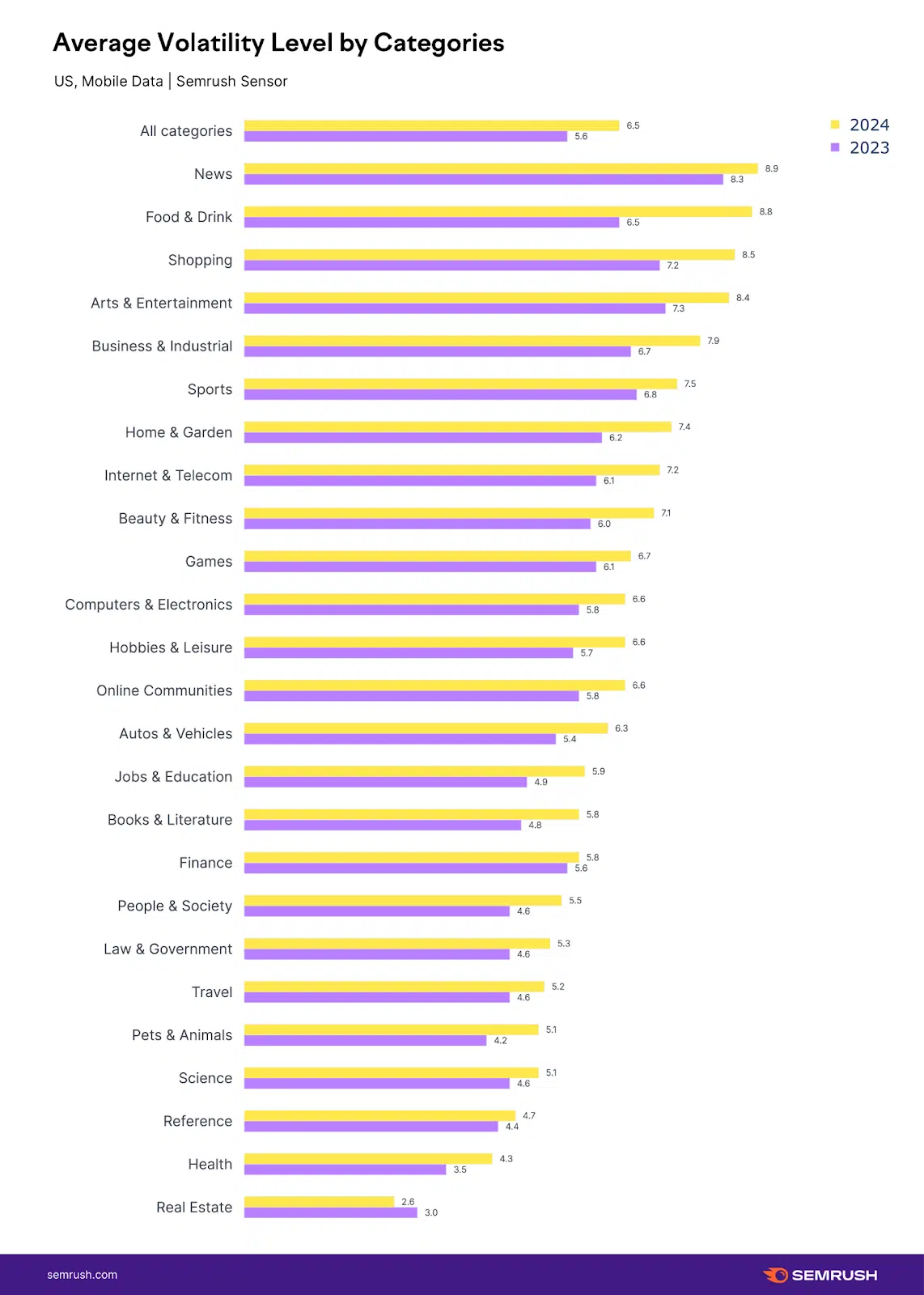
If you look at ecommerce, the vertical had literally the same level of rank volatility on both desktop and mobile in 2024. However, on mobile, the volatility average was 5 points higher.
The gap between the mobile and desktop volatility increase is due to the higher levels of mobile volatility in 2023, which resulted in less of an increase relative to 2024.
However, the levels of absolute volatility are the same across devices. (Again, using the Shopping vertical, the average volatility was at 8.5/10 on both devices in 2024.)
By the way, a volatility score of 8.5 is out of this world.
All these numbers, when factoring in the volatility levels in 2023 and then the increase of them in 2024, are out of this world.
The SERP is not safe.
Dig deeper: How to diversify your traffic sources
Is increased rank volatility a lasting trend or a temporary spike?
An increase in average volatility in 2024 doesn’t tell the whole story.
We need to determine if a single event skewed the data – perhaps one or two months of extreme volatility.
The answer? No.
Volatility in 2024 was widespread. Except for July (and to some extent August), the year was consistently more volatile from the start.
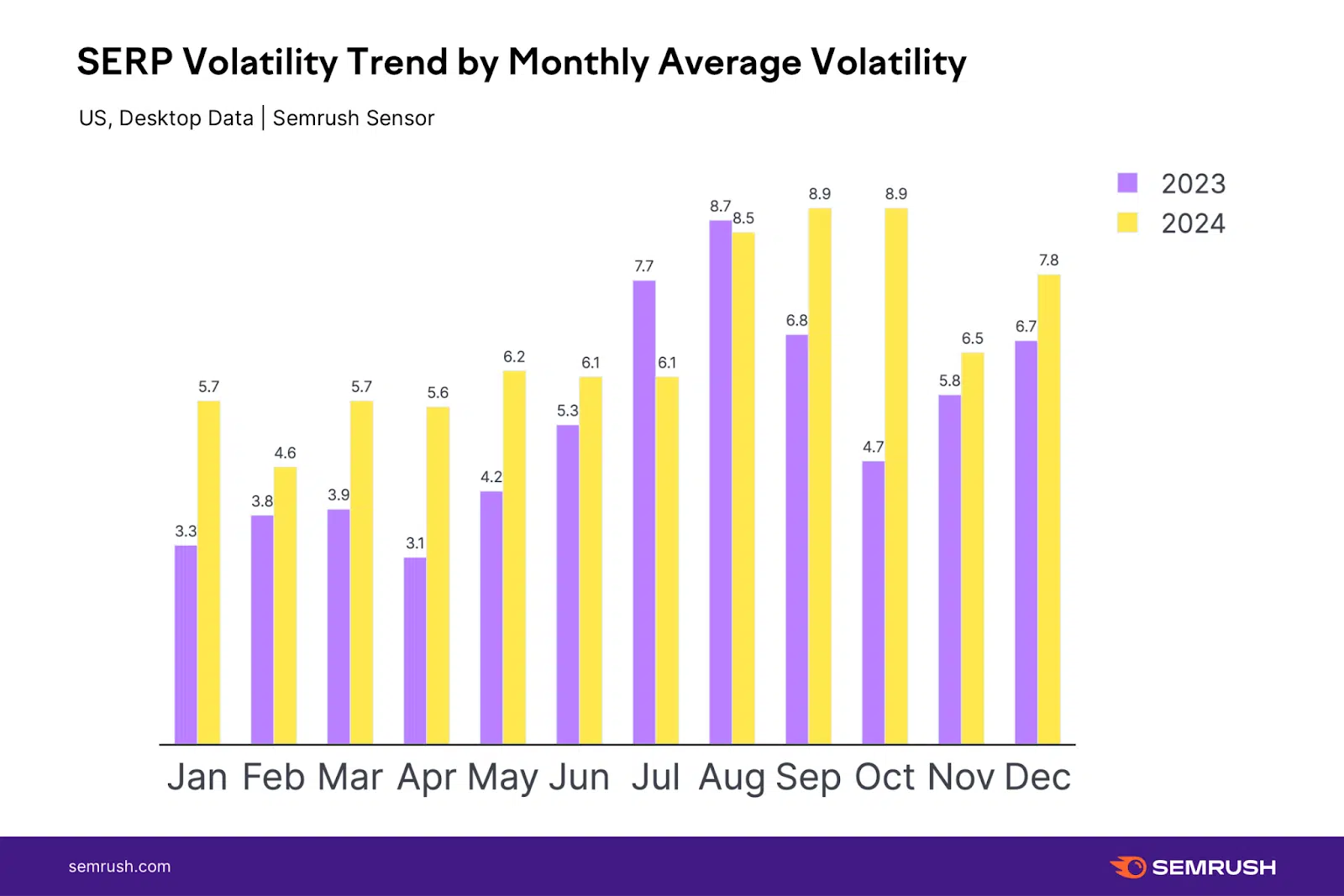
July 2023 is interesting to recall because there was no official update.
The volatility you see above in July 2023 was the result of an odd and ongoing period of extreme rank volatility that happened around the middle of that month:
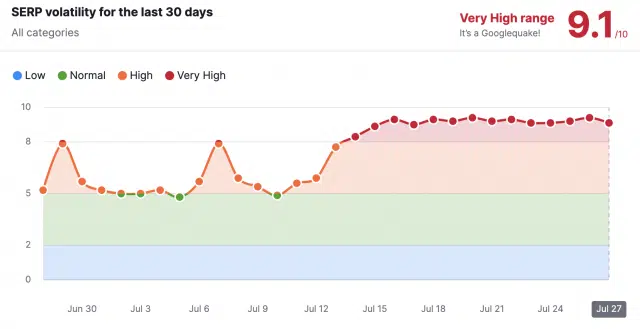
The upshot and the importance of the data is that it means we’re not just in a more volatile rank period that may or may not abate.
Rather, it would appear we’re in a new scenario of what volatility on the SERP looks like.
I can only speculate that it will get worse as Google has been reported to say they are moving to continuous and ongoing algorithm updates.
How drastic is drastic?
Another question neither the average level of volatility nor the volatility trends answer is how volatile?
Meaning, how drastic is the rank movement?
It’s entirely possible that smaller micromovements are a big part of the more volatile SERP (which, for the record, was already incredibly volatile for years – more on that later).
Standard deviation is one of the best metrics to measure rank volatility.
When you look at the baseline and how far off the volatility is, rank volatility is noticeably less drastic:
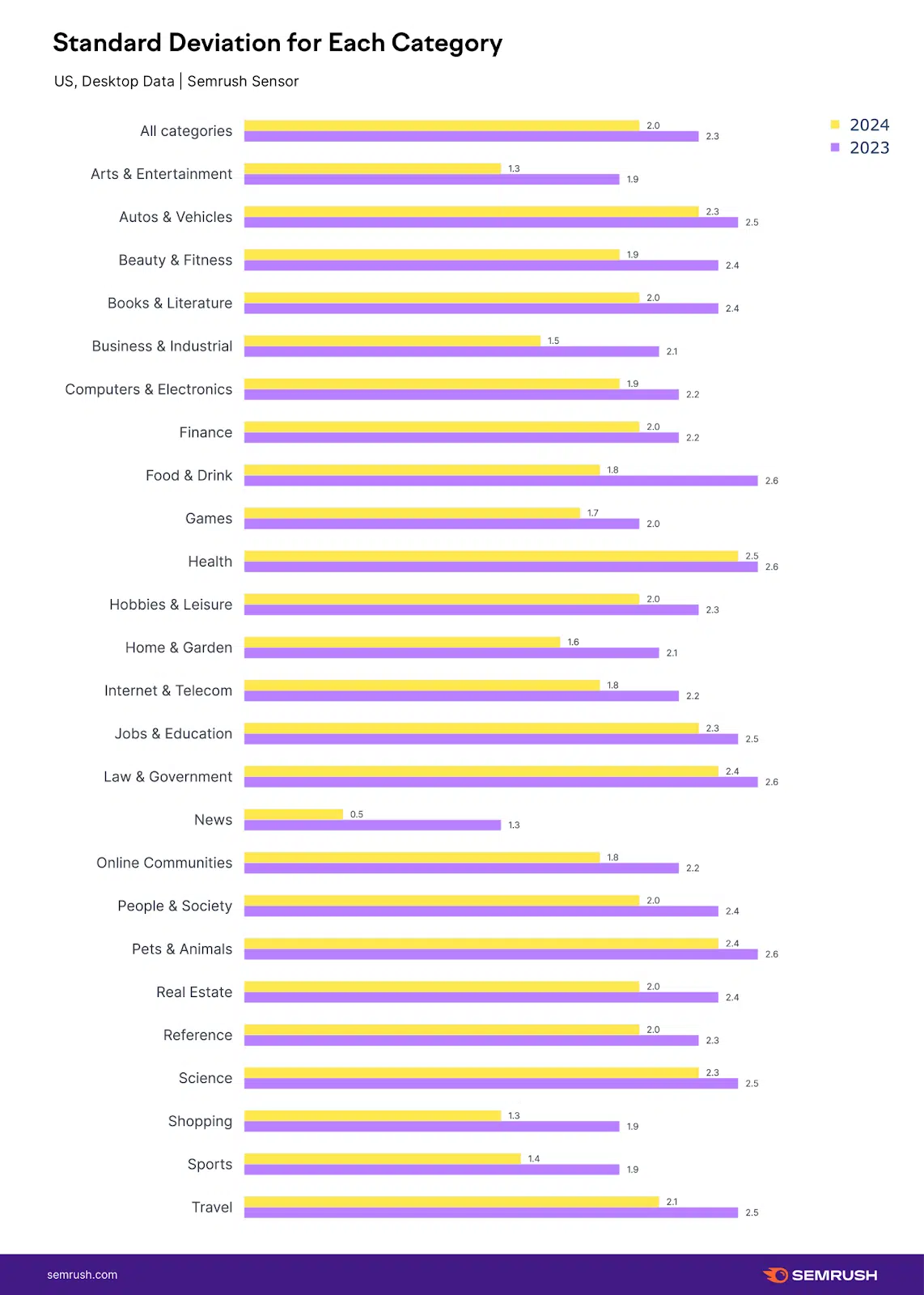
Every vertical saw a decrease in the standard deviation relative to 2023, aside from one (and the “news” SERP is its own beast).
Now we have a scenario where the “amount” of volatility increased, but the extent of the movement itself decreased relative to 2023.
Do not mistake that for “Oh, rank isn’t fluctuating in a drastic manner.” It’s relative to 2023, not in absolute.
If we take the Dolorean to 88 mph, we’ll see that back in 2021 standard deviation, outside of News, ranged between 1.15 and 1.69:
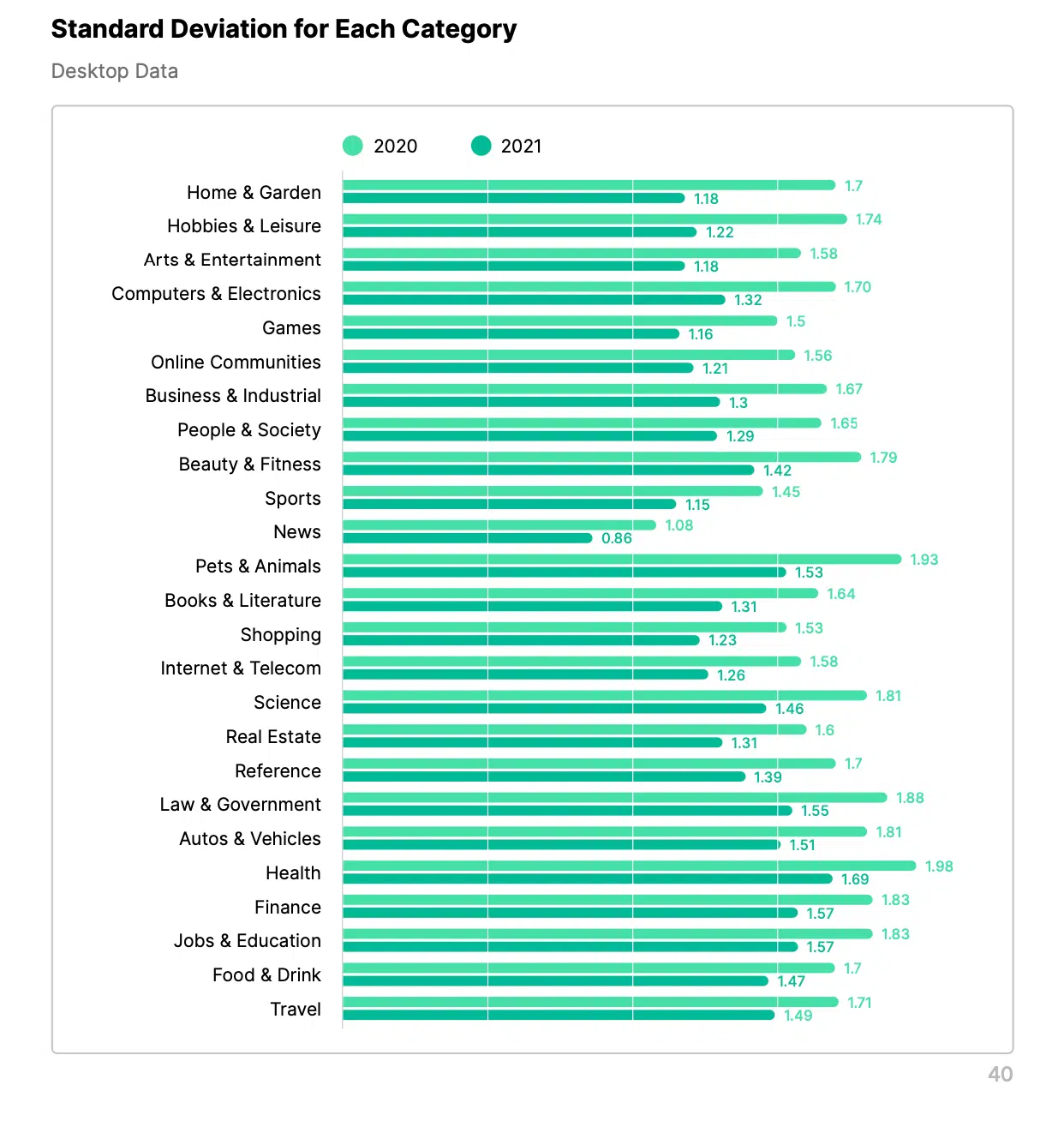
That range in 2024 (again outside of News) is 1.3 – 2.5. Rank is not “less volatile” over time.
The average level of rank fluctuation may not be as drastic as in 2023, but as a paradigm, we are not even close to the levels seen in 2021 and have surpassed the higher extremes of rank movement seen in 2020.
Back in 2020, we were looking at standard deviations above 1. Now, we’re talking about deviants above 2 (of which I have four above 2 at home).
We can still pull back another layer.
Is the reason the standard deviation is higher overall related to a few strong spikes of colossal rank volatility?
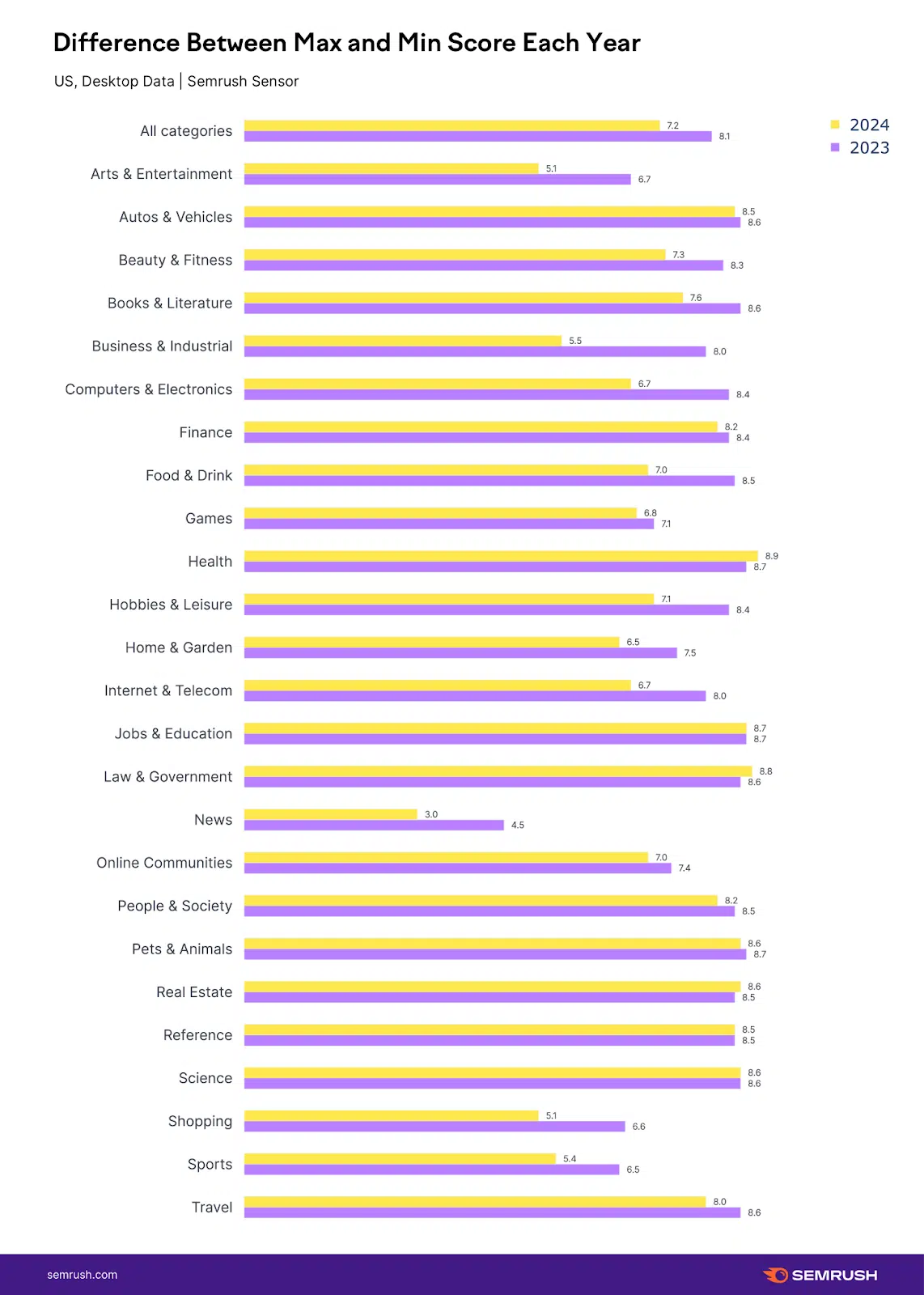
That doesn’t appear to be the case.
The above graph shows a narrowing of the gap between the minimum and maximum levels of volatility.
The difference between minimum and maximum volatility in 2023 was 8.1 points, down to 7.2 in 2024.
That’s a less drastic “spiking” of max volatility (relatively speaking).
There are two (if not more) possible reasons for this:
- The minimum score was higher, meaning we started at a higher level of volatility, which would make the gap between the minimum and maximum levels of volatility narrower.
- There were fewer large spikes but overall more “less drastic” rank movement so the levels just never got as high in 2024. Thus, the gap between the minimum and maximum levels of volatility is narrower.
If you look at all the data together (see, there’s a method to my madness), some signs point to more volatility that is less drastic overall.
Why?
- The average amount of volatility is up in 2024.
- The rank movement is less drastic overall in 2024 (see standard deviation).
Thus, to apply Occam’s Razor (which has nothing to do with actual razors), the most likely scenario behind the narrowed gap between minimum and maximum volatility is that the volatility, while more frequent, did not get as many “highs” as it did in 2023.
However, the counterargument would be the month-by-month volatility trends we saw above (adding here again for convenience), which show that the jump in the amount of volatility was steeper in 2023 than in 2024:

It’s not hard to see. August 2023 and August 2024 show just about the same levels of volatility. But look where the amount of volatility started in 2023, far lower than in 2024.
One might speculate that if the amount of volatility spiked like it did in 2023, so did the levels of volatility.
This is a fancy way of saying, I don’t know – which I am not supposed to say in official SEO articles. (So you didn’t read that).
But it also brings me to my next data point. The pivots are so good here it feels like a podcast.
Things are volatile, but who’s counting?
Me.
I am counting.
Did you know that Semrush only recorded 15 days or low volatility in 2024?
Of course, not. Who would actually know that off the top of their heads? That’s just weird.
But it’s true.
On desktop, there were just 15 days of low volatility and just 83 days of “normal” volatility.
For the record, yes, 2024 has 366 days, not 365. It was a leap year. I know how to add numbers.
So, just assume there is one less day of high volatility to make yourself feel better.
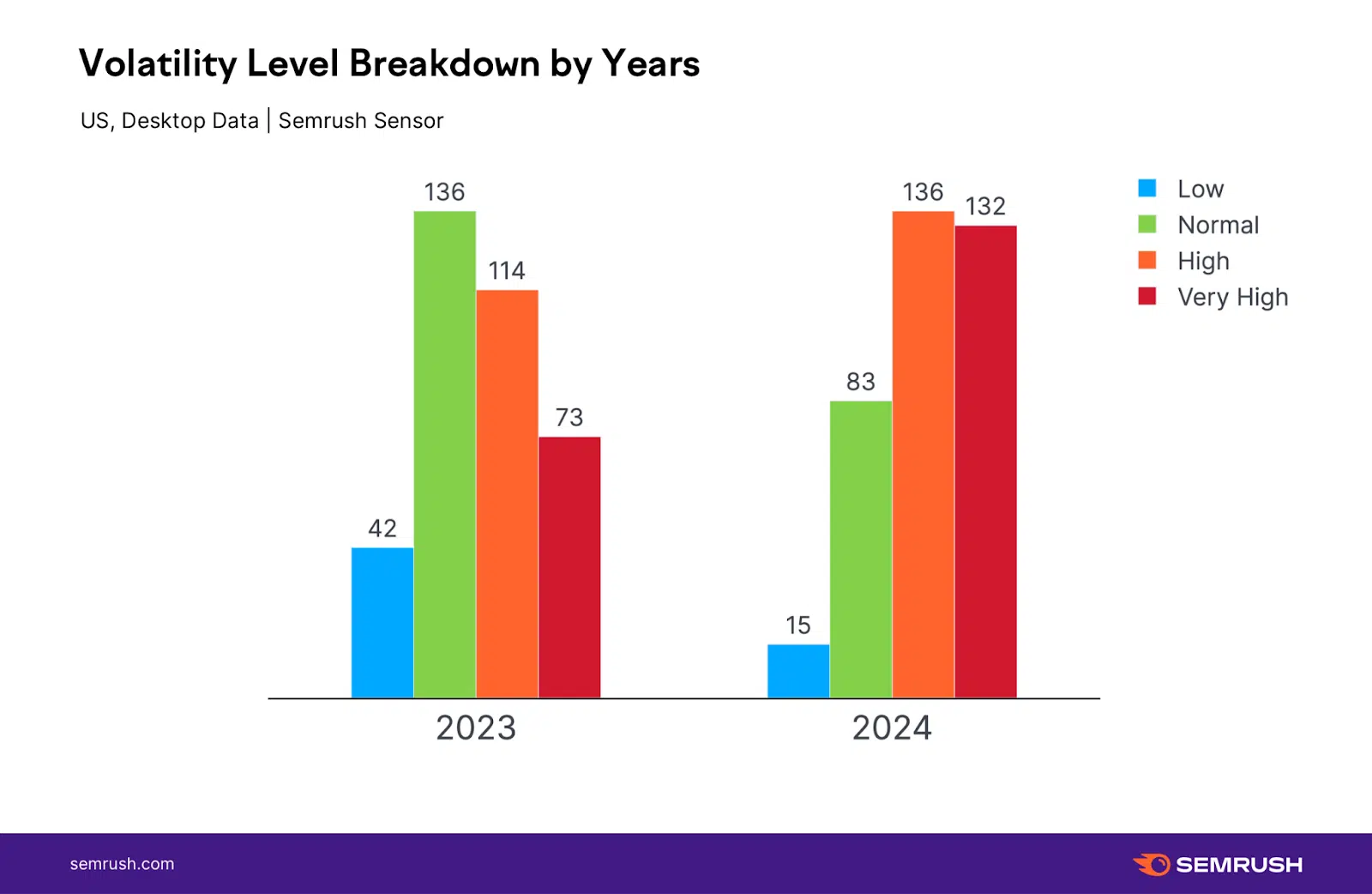
By the way, that means a 64% reduction in the number of days of low volatility in 2024 and a 39% reduction in days of normal volatility.
Conversely, there was a 19% increase in “high volatility” days in 2024 and an absolutely massive increase of 80% in “very high volatility” days!
Slightly different on mobile with a few more days of low volatility throughout 2024 (although the number of high volatility days was the same):
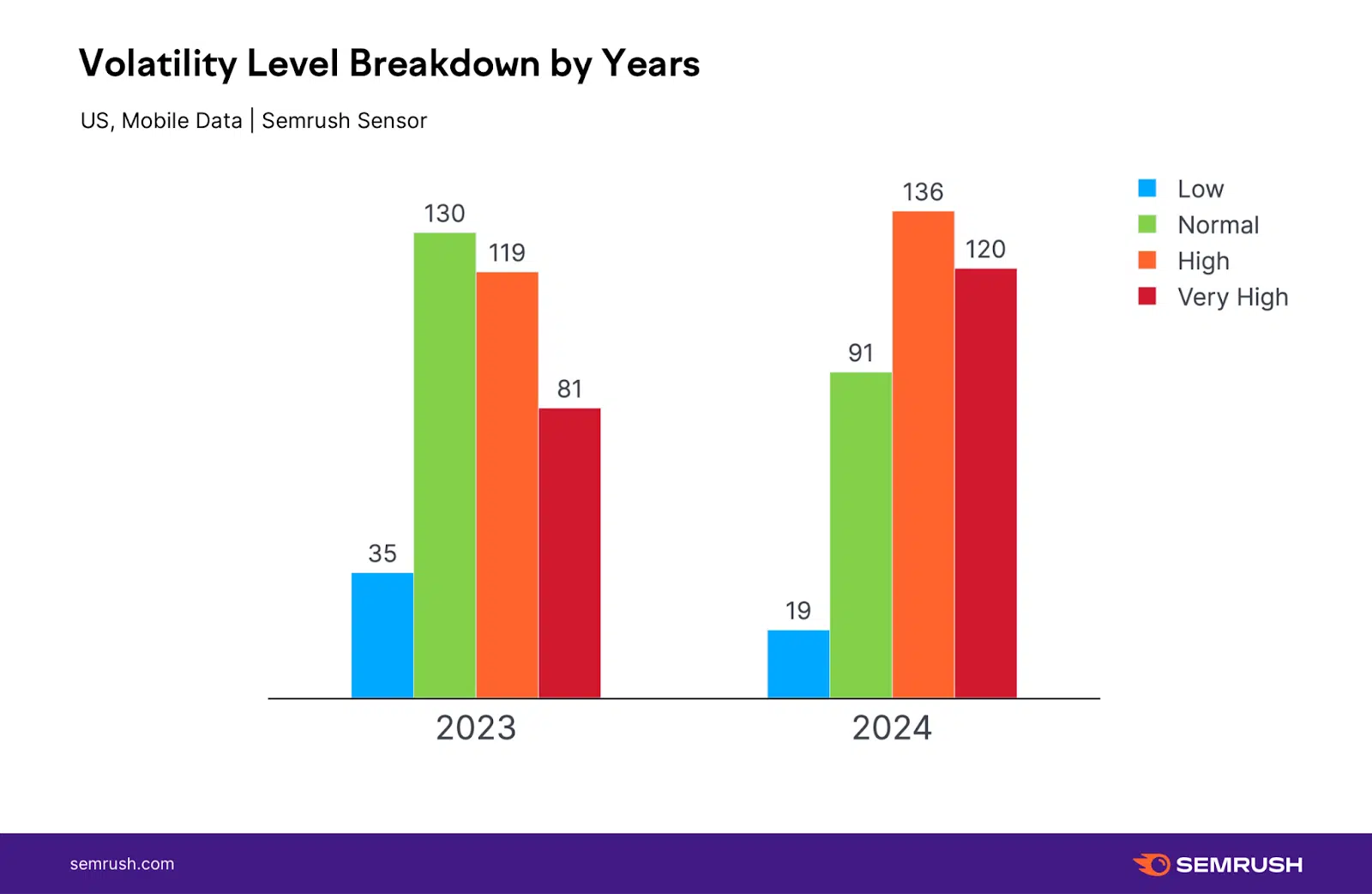
However, there were 12 fewer “very high” volatility days on mobile in 2024, so that’s good.
But mainly, none of it is good.
Roughly 78% of 2024 was volatile, with 36% of the year being very volatile (desktop). That feels like a nightmare. For many, it was and still is.
More volatility? Who freaking cares?! (Or as most Search Engine Land articles put it: why we care)
You.
At least you should. Our conception of what Google is as a marketing channel is starting to shift.
First, the results are less than stellar at times.
I was Googling a medical condition, and I was forced to choose between the same content from different websites such as the Mayo Clinic, Web MD, whatever, or Reddit.
That’s like having to choose between strawberry ice cream or strawberry ice cream with nuts.
Then there’s the whole LLM thing, AI search engines and AIOs, AI-generated content, AI something whatever, and yada, yada, yada.
And then, on top of that, content consumption trends have totally changed IMHO (they’re constantly changing, BTW).
Oh, and I forgot about Reddit being firehosed into the SERP. (Would you like sprinkles on that ice cream?)
On top of all of that, the SERP is a heap of volatility. That’s a lot.
It’s like Thanksgiving dinner with your family and your in-laws, and all that’s being served is boiled tofu.
Also, they don’t have a TV, so you can’t watch football, and they don’t have beer; they have Zima from 1992.
So what should you do about it?
I didn’t say I was giving advice; I was just showing why you should care.
What you should do about it is a whole other conversation. And yeah, it goes far beyond “diversify your channels” or “aim for owned audiences.”
Personally, I think it means taking a very hard look at how we approach audiences and resonate with them.
Let that sink in for now.
Dig deeper: SEO beyond Google: Building your brand on Reddit, Quora, TikTok and more
Contributing authors are invited to create content for Search Engine Land and are chosen for their expertise and contribution to the search community. Our contributors work under the oversight of the editorial staff and contributions are checked for quality and relevance to our readers. The opinions they express are their own.
Related stories